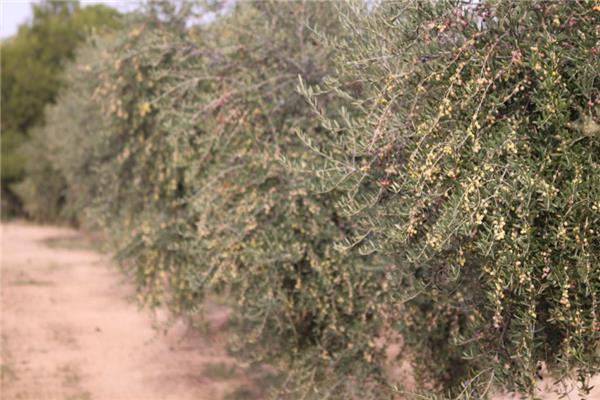Matters needing attention in olive tree culture and pest control
It is undoubtedly a pleasure to cultivate an olive tree whenever it comes to the fruit stage, picking the full, crisp, slightly sweet and refreshing olive fruit, or making it into a snack, or drying it for medicine, or stir-frying with ingredients, so it is a pleasure to cultivate olive trees. what do you need to pay attention to?

Matters needing attention in olive tree culture
Habits: olive trees are very strong, cold-resistant, drought-resistant, disease-resistant and fire-resistant, and can grow for a long time. Their roots are so strong that they still have the ability to regenerate even if the aboveground structure is destroyed. Olive trees grow well in the hot, dry Mediterranean, cool summers and humid winters. The coastal climate is the best.
Temperature: although olive trees like heat, they can withstand minus 6-7 degrees Celsius (21-23 degrees Fahrenheit) in winter.
Soil: they obviously prefer calcareous soil and can flourish on limestone slopes and cliffs. They can grow in any weak soil, even red soil with good drainage. But in fertile soil, they are more likely to get sick. The maximum depth of the soil around the plant should be 20 cm to avoid destroying the roots of the earth's surface. This method can make the fertilizer mix with the soil, and make the soil absorb Rain Water effectively and maintain the humidity for as long as possible.
Humidity: because of their strong and broad roots, they can endure long-term droughts in summer. They grow better in areas with 14-16 inches of annual rainfall, or in dry summers around 40 degrees Celsius (104 degrees Fahrenheit).
Fertilizer and water: give priority to nitrogen fertilizer, match other fertilizers properly, and take frequent and thin application as the principle, generally once every two months, or before and after the extraction. Under dripping water around the crown, the method of fertilization is to open a ring ditch with a depth of 20 centimeters, or two half-moon-shaped ditches, and apply fertilizer into the ditch. If it is liquid fertilizer, cover the soil after it drips, and then cover the soil after the dry fertilizer is applied. In summer, the early stages of fruit growth and pit hardening are watered every 2-3 weeks.

Disease control of olive trees
1. Planthopper:
The damaged leaves of healthy and luxuriant olive leaves lost green and yellowing, uneven and twisted, in which the young fruit stage of spring shoot (April-June) and autumn shoot stage (August-October) were the peak period of damage.
Prevention and treatment: spray the medicine when the new shoots are pulled out twice in the spring and autumn. The available agents are: Wanling: 2000 times liquid, monocrotophos 1500 times liquid or omethoate, isocarbophos 1000 times liquid and so on.
two。 Scale insects:
The leaves showed yellowish spots after damage, and the twigs grew poorly or even withered after damage.
Prevention and treatment: timely pruning to make the crown ventilated. If pests are found, the following agents should be used to kill them: 700times of EC, 1000 times of omethoate and isocarbophos, etc.

3. Aphids:
This is also the main pest that harms the new shoots of olives. Nymphs and adults gather on the tender leaves to suck juice, which makes the shoots yellow, the new leaves curl, hinders the growth, affects the tree potential and induces soot disease. It occurs all year round, especially in the dry season, and the harm is serious.
Control method: ① shoot stage spray. When there are aphids, you can use 1000 times of malathion, or 1200 times of imidophos, or 2000 times of dichlorvos, or 2000 times of aphid fog, or botanical pesticides such as fish rattan essence and nicotine. ② protects and utilizes natural enemies. Ladybugs, lacewings, aphid flies and aphid cocoon wasps are important natural enemies of aphids. If there are a large number of natural enemies in the garden, they can not spray or spray less to protect them.
4. Soot disease:
Soot disease, also known as soot mildew, is a necessary fungal ☆ ☆ disease, which occurs on branches, leaves and fruits, showing dark brown mildew spots at first, and then expands into a black mildew layer around, showing soot-like, easy to detach.
Control methods: ① can control aphids of woolly scale insect and star room planthopper. After ② cleared the garden in winter, the spray stone-sulfur mixture was 0.8: 1 Baume. ③ is properly trimmed to facilitate ventilation and light transmission. ④ spray protection. The commonly used fungicides are 1% Bordeaux solution (1 kg of copper sulfate and 1 kg of quicklime each), 50% methyl thiophanate 800 times, and 50% carbendazim 800 times.

This is the end of the introduction on how to cultivate olive trees and how to control diseases and insect pests that olive trees may suffer from. I hope that after reading the above introduction, it will increase your confidence in cultivating olive trees and let everyone eat delicious olive fruits during the harvest season.
Related
- Wuhan Hospital Iron Tree Blooming Result Was Instantly Frightened by the Gardener Master
- Which variety of camellia is the most fragrant and best? Which one do you like best?
- What is the small blue coat, the breeding methods and matters needing attention of the succulent plant
- Dormancy time and maintenance management of succulent plants during dormancy
- Minas succulent how to raise, Minas succulent plant pictures
- What are the varieties of winter succulent plants
- How to raise succulent plants in twelve rolls? let's take a look at some experience of breeding twelve rolls.
- Attention should be paid to water control for succulent plants during dormant period (winter and summer)
- Watering experience of twelve rolls of succulent plants
- Techniques for fertilizing succulent plants. An article will let you know how to fertilize succulent plants.



